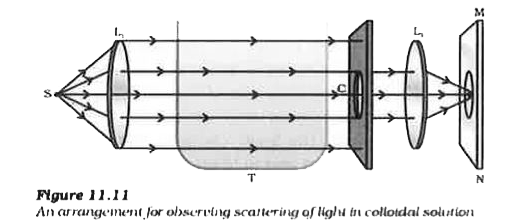Write an activity for observing scattering of light in colloidal solution. Support the activity with diagrams.Solution in Kannada
Aim of the activity: To study Tyndall effect or scattering of light by colloidal particles.

(1) Place a strong source of white light (S), a convex lens [L1], a transparent glass tank [T] containing clear water [about 2 litres], a cardboard [C ] with a circular hole, another convex lens [L2] and a screen [MN] in a straight line as shown in the figure.
(2) Focus white light from S into L1 so that a parallel beam of light is obtained.
(3) This beam of light passes through T, the hole in the cardboard, L1 and finally falls on the screen.
(4) Dissolve about 200 g of sodium thiosulphate (hypo-chemical formula Na2S2O3) in the tank water and later add 1-2 ml of concentrated sulphuric acid into it.
Inference : Sulphur particles starts precipitating in about 2-3 minutes and blue light starts coming from three sides of the glass tank. This is because minute sulphur particles scatter light of short wavelengths [blue colour] to a maximum extent. This helps us to understand why or sky appears blue.
We also observe that initially orange light comes out of the fourth side of the tank [the one facing the circular hole] and falls on the screen, Later the colour changes by scattering and the least scattered red light comes out of the colloidal solution. This helps us to understand why the sun appears red during sunrise or sunset.
Topper's Solved these Questions
- THE HUMAN EYE AND THE COLOURFUL WORLDBOOK - ZEN PUBLICATIONCHAPTER - THE HUMAN EYE AND THE COLOURFUL WORLDEXERCISE - ZEN ADDITIONAL QUESTIONS SECTION - HIGHER ORDER THINKING SKILLS (HOTS)
26 Videos
- THE HUMAN EYE AND THE COLOURFUL WORLDBOOK - ZEN PUBLICATIONCHAPTER - THE HUMAN EYE AND THE COLOURFUL WORLDEXERCISE - ZEN ADDITIONAL QUESTIONS SECTION - SHORT ANSWER TYPE QUESTIONS - II
28 Videos
- SOURCES OF ENERGYBOOK - ZEN PUBLICATIONCHAPTER - SOURCES OF ENERGYEXERCISE - ZEN ADDITIONAL QUESTIONS SECTION (HIGHER-ORDER THINKING SKILLS [HOTS] )
14 Videos
Similar Questions
Rohan is not able to contract his iris properly due to defect in his eyes. Rohan would not be able to see :
(i) in dim light (ii) in bright light
(iii) nearby objects (iv) distant objects
View SolutionDraw a labelled diagram of the human eye. What is the significance of the blind spot ?
View SolutionState the areas where acid rains are most likely.
View SolutionOn passing light from colloidal solution, the effect due to scattering of light is known as :
View Solutionकिसी कोलॉइडीय विलयन में निलंबित कणों से प्रकाश के प्रकीर्णन को __________ प्रभाव कहते हैं।
View Solutionकिसी कोलॉइडी विलयन में निलंबित कणों से प्रकाश के प्रकीर्णन को कहा जाता है
View Solutionकोलॉइडल विलयन में प्रकाश के प्रकीर्णन का किरण आरेख बनाइये।
View SolutionThe scattering of beam of light when light passes through a colloidal solution is………..
View SolutionThe phenomenon of scattering of light by the sol particles is called
View Solutionకొల్లాయిడల్ ద్రావణం గుండా ప్రసరించు కాంతి విక్షేపణం చెందుటను ............... ప్రభావమంటారు.
View SolutionThe intensity of scattered light depends on the type of collodial solution and the size of the colloidal particles.
View SolutionBriefly describe an experimental arrangement for observing scattering of light in colloidal solution.
View SolutionWrite an activity for observing scattering of light in colloidal solution. Support the activity with diagrams.
View Solution(a) State the reasons which lead to hypermetropia. With the help of suitable diagram explain this defect of vision and its correction.
(b) Draw diagram of an experimental arrangement for observing scattering of light in colloidal solution. Name the two chemicals used in this activity.
View Solution(a) Write an activity for observing scattering of light in colloidal solution.
(b) On the basis of this activity explain why sky appears red at sunrise or sunset.
View Solution
